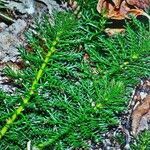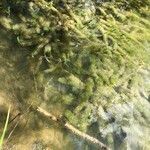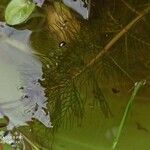Plants mostly monoecious, rarely with bisexual flowers. Perennation by clavate turions. Stem robustly branched or unbranched, 50-150 cm; internodes often shorter than leaves. Submerged leaves 4-6-whorled, pectinate, narrowly ovate in outline, 3-5 × 1.5-2.5 cm; segments in 10-20 pairs, filiform, 1-2.5 cm. Inflorescence a terminal spike of 4-whorled flowers, 7-20 cm; bracts pectinate or absent. Male flowers: bracteoles lanceolate-lobed; calyx broadly campanulate, ca. 1 mm, 4-parted nearly 1/2 of way to base; petals white or greenish, obovate, 2-2.5 mm; stamens 8. Female flowers: bracteoles pectinate, 1-5 × as long as flower; calyx tubular, shortly lobed; petals greenish or white, minute. Fruit 4-loculed, subglobose, ca. 3 mm; mericarps smooth or sparsely verrucose along margins. Fl. and fr. Apr-Sep.
Much like no. 9 [Myriophyllum sibiricum Kom.]; lvs with 9–17 segments per side; floral bracts less strongly reduced and modified, those subtending the pistillate fls (1–)2–several times as long as the fl, sometimes to 1 or even 1.5 cm, even those subtending the staminate fls evidently cleft or laciniate-toothed; pistillate fls with persistent sep mostly 0.5–1 mm; staminate fls with yellow-green pet; stamens 8, less often 4; turions abscised from the stem in late fall or early winter, dark yellow-green, their lvs less modified than in no. 9; 2n=28. In acid to circumneutral waters to 3 m deep; circumboreal, s. to Mass., N.Y., Ind., Ill., Nebr., and Utah. (M. hippuroides, misapplied to the phase with 4 stamens)
A water herb. It keeps growing from year to year. The stems are thick and up to 3 m long. The rhizome forms roots. The leaves are 20-35 mm long. They are divided. There are 20-35 segments.




